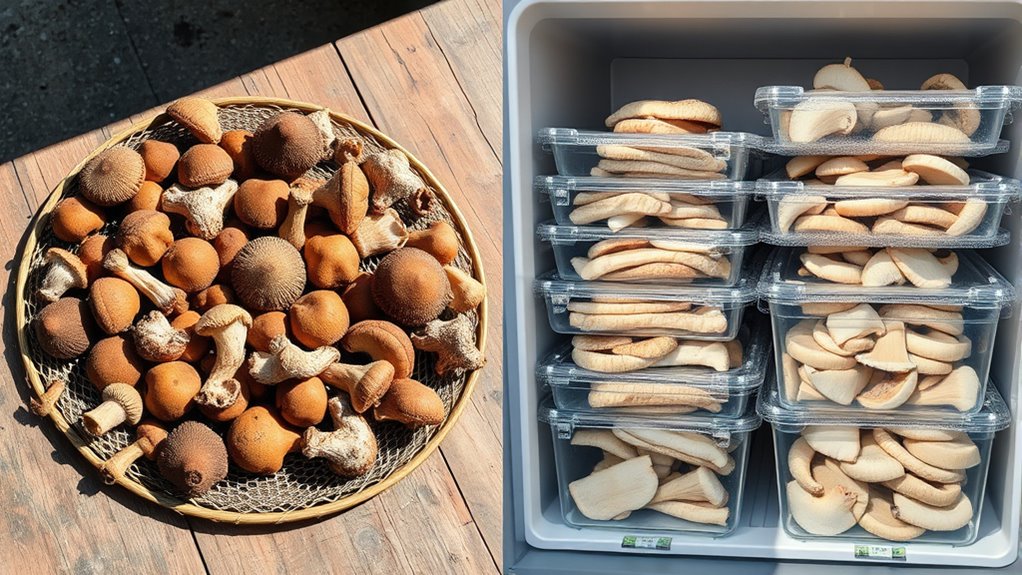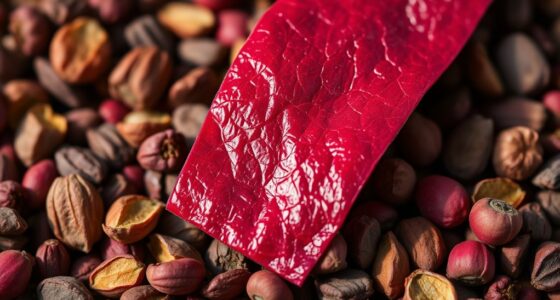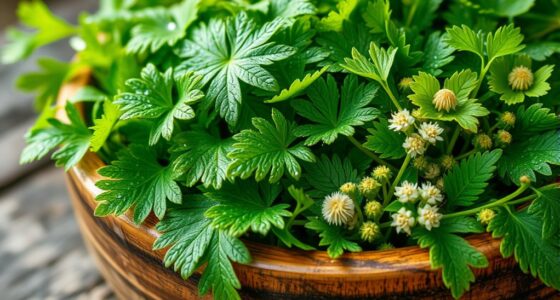To preserve wild mushrooms, choose fresh, firm specimens and use proper drying or freezing techniques. For drying, slice evenly and use air, oven, or dehydrator methods, ensuring even dehydration to lock in flavor. Freezing involves blanching, cooling quickly, and storing in airtight containers to maintain nutrients. Drying concentrates flavor but may reduce some nutrients, while freezing keeps most nutrients and texture intact. Continue exploring to discover the best method for your needs.
Key Takeaways
- Drying concentrates flavors and extends shelf life but causes some loss of heat-sensitive nutrients.
- Freezing preserves most nutrients and original texture but may require blanching and careful packaging.
- Use air drying or dehydrators for efficient, uniform drying; freeze mushrooms after cleaning and blanching.
- Drying is best for long-term storage and flavor enhancement; freezing is ideal for preserving freshness and nutrients.
- Both methods require proper preparation, packaging, and labeling to maintain quality and safety over time.
Selecting the Right Mushrooms for Preservation

Choosing the right mushrooms is essential for successful preservation, whether you plan to dry or freeze them. Proper wild mushroom identification guarantees you’re harvesting edible varieties and avoiding toxic look-alikes. Focus on mushrooms that are fresh, firm, and free of blemishes or rot. Harvest at the right time—usually when caps are fully developed but before they start to spoil—to maximize flavor and texture. Knowing the specific harvest timing for each type helps prevent overripe or underdeveloped mushrooms, which can affect preservation quality. Always double-check identification guides or consult experts if you’re unsure. Selecting mushrooms at their peak ensures they dry or freeze well, maintaining their best flavor and texture over time. Proper selection is the foundation of successful preservation.
Techniques and Equipment for Drying Wild Mushrooms

After selecting the best mushrooms for preservation, the next step is to dry them effectively. You can choose from various dehydration techniques, such as air drying, oven drying, or using a food dehydrator. Air drying works well in dry, ventilated spaces and involves hanging mushrooms or spreading them on racks. Oven drying requires low heat settings and close monitoring to prevent overcooking. Using drying equipment like a food dehydrator provides consistent temperature control, making the process quicker and more reliable. Confirm your mushrooms are sliced evenly for uniform drying. Whichever method you select, proper drying equipment and techniques help preserve your wild mushrooms’ flavor and texture, preventing mold and spoilage. Properly dried mushrooms can last months and retain their best qualities. Dehydration methods play a crucial role in maintaining the quality of dried mushrooms.
Best Methods for Freezing Wild Mushrooms

Freezing wild mushrooms is an excellent way to preserve their freshness and flavor for long-term use. To maintain ideal mushroom texture and flavor enhancement, start by cleaning and slicing them evenly. Blanch the mushrooms in boiling water for 1-2 minutes to halt enzyme activity and lock in flavor. Immediately transfer them to an ice bath to stop cooking. Pat them dry thoroughly to prevent ice crystals that can damage texture. Flash-freeze the slices on a baking sheet until firm, then transfer to airtight containers or freezer bags, removing excess air. Label and date your packages. This method helps retain the mushrooms’ natural texture and enhances flavor over time. Proper freezing techniques ensure your wild mushrooms stay delicious and ready for use whenever you need them. Additionally, understanding how contrast ratio impacts image quality can help in selecting the right display for your home cinema setup.
Storage, Shelf Life, and Usage Tips

Proper storage is key to maximizing the shelf life and flavor of your wild mushrooms after freezing. To preserve their mushroom aroma, keep them in airtight containers or vacuum-sealed bags to prevent freezer burn and odor absorption. Label each package with the date to track freshness. Be mindful of preservation challenges, such as moisture and temperature fluctuations, which can degrade quality and cause spoilage. For best results, store mushrooms at consistent freezing temperatures and avoid thawing and refreezing. Use frozen mushrooms within 6 to 12 months for ideal flavor and texture. When ready to use, add them directly to cooked dishes to retain their aroma and avoid mushiness. Proper storage helps maintain their quality and ensures your wild mushrooms stay flavorful and fresh longer. Additionally, maintaining a stable temperature is crucial to preventing spoilage and preserving their natural qualities.
Comparing the Nutritional and Flavor Retention of Both Methods

When comparing drying and freezing, it’s clear that each method affects the nutritional content and flavor of wild mushrooms differently. Drying often causes some nutritional loss, especially in vitamins sensitive to heat and air exposure, but it excels at flavor preservation by concentrating the mushroom’s natural taste. Freezing better maintains most nutrients, especially water-soluble vitamins, but may slightly diminish flavor over time. Additionally, understanding the environmental impact of each preservation method can help make more sustainable choices. Here’s a quick comparison:
- Nutritional loss: Higher in drying, minimal in freezing
- Flavor preservation: Superior in drying, acceptable in freezing
- Texture impact: Drying alters texture considerably, freezing retains original texture
- Overall retention: Freezing preserves nutrients better, drying enhances flavor concentration
Choose based on whether you prioritize flavor or nutritional value.
Frequently Asked Questions
How Do I Tell if Dried Mushrooms Are Fully Dried?
To tell if your dried mushrooms are fully dried, check their moisture content and look for visual cues. They should feel light, brittle, and snap easily when bent. Visually, they should be shriveled, darkened, and free of any soft or damp spots. If there’s still moisture or softness, give them more drying time. Properly dried mushrooms will store well and retain flavor without mold or spoilage.
Can I Combine Drying and Freezing Methods for Better Preservation?
You can definitely combine drying and freezing to enhance preservation strategies. First, thoroughly dry your wild mushrooms to reduce moisture, then freeze them to prevent spoilage and maintain flavor. This combined approach offers the benefits of both methods, extending shelf life and preserving quality. Just make certain the mushrooms are fully dried before freezing, as residual moisture can cause spoilage. Using both methods together gives you a reliable way to store your wild mushrooms long-term.
Are There Specific Mushroom Types That Don’T Freeze Well?
Some mushroom types don’t freeze well because their texture becomes mushy or rubbery after thawing, which poses preservation challenges. For instance, delicate mushrooms like chanterelles and enoki tend to lose their firm texture and may become slimy. If you want to maintain their quality, drying is often a better option. You should consider the mushroom’s texture and how it reacts to freezing before choosing your preservation method.
What Are Common Mistakes to Avoid During Drying or Freezing?
You should avoid incorrect drying techniques, like uneven or too quick drying, which can spoil your mushrooms, and improper packaging that exposes them to moisture or air. Make certain you dry mushrooms thoroughly and store them in airtight containers to prevent mold or freezer burn. Also, don’t freeze mushrooms without proper prep, as they can become mushy or develop freezer burn. Proper care ensures your mushrooms stay fresh and flavorful.
How Do Storage Conditions Affect the Quality of Dried or Frozen Mushrooms?
Think of your mushrooms as treasures needing a watchful guardian. Your storage conditions, like moisture control and temperature regulation, directly influence their quality. Too much moisture causes mold, while fluctuating temperatures can spoil texture and flavor. By maintaining a cool, dry, and stable environment, you preserve their freshness and potency. Proper storage keeps your wild mushrooms at their best, much like a well-kept secret waiting to be revealed in perfect condition.
Conclusion
Choosing between drying and freezing wild mushrooms is like picking the perfect paintbrush for your masterpiece. Both methods preserve their flavor and nutrition, but each has its own story to tell. Drying offers a shelf that stretches endlessly, while freezing keeps their freshness alive like a secret garden frozen in time. Whichever you choose, your mushrooms will continue to delight your senses, turning simple foraging into a culinary adventure that lasts.










